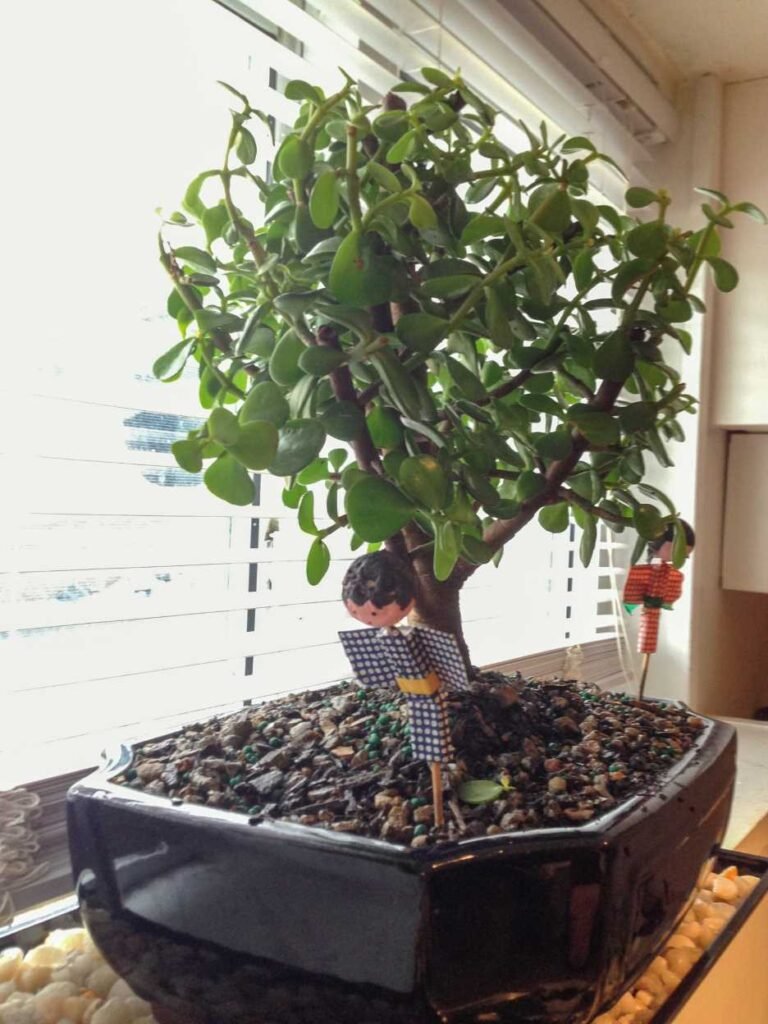Jade plants, also known as Crassula ovata or money plants, are popular houseplants appreciated for their succulent leaves, easy care, and longevity. Originating from South Africa, these plants are believed to bring good luck and prosperity, making them a favorite in homes and offices.
While jade plants typically grow as shrubs, with proper care and techniques, you can train them to grow into tree-like forms. This guide will provide an in-depth look into the steps and considerations needed to transform a jade plant into a tree.

Table of Contents
Understanding Jade Plants
Before diving into the steps of transforming a jade plant into a tree, it’s essential to understand the basics of this succulent.
Characteristics
- Leaves: Thick, oval-shaped, and fleshy, jade plant leaves store water, which helps the plant survive in arid conditions.
- Stems: Initially green and fleshy, the stems thicken and become woody with age, providing a sturdy structure for the plant.
- Roots: Jade plants have a shallow but extensive root system, making them efficient in absorbing water and nutrients from the soil.
- Flowers: Under ideal conditions, mature jade plants produce small, star-shaped white or pink flowers.
Growth Conditions
- Light: Jade plants thrive in bright, indirect sunlight. Direct sunlight can cause leaf burn, while insufficient light can lead to leggy growth.
- Water: These succulents prefer well-drained soil and infrequent watering. Overwatering can lead to root rot.
- Temperature: Jade plants are best kept in temperatures between 65°F and 75°F (18°C – 24°C). They can tolerate cooler temperatures but should be protected from frost.
- Soil: A well-draining soil mix, such as a cactus or succulent mix, is ideal for jade plants.
Preparing to Grow a Jade Plant into a Tree
Selecting the Right Plant
Start with a healthy jade plant. Look for a plant with a thick stem, numerous leaves, and no signs of pests or disease. While you can start with a small plant, having a more established one will give you a head start.
Choosing the Right Pot
A sturdy, well-draining pot is essential. Since jade plants can become top-heavy, a heavier pot can provide better stability. Ensure the pot has drainage holes to prevent water from accumulating at the bottom.
Soil Preparation
A well-draining soil mix is crucial. You can use a commercial cactus or succulent mix or create your own by mixing potting soil with sand or perlite. This ensures that water drains quickly, preventing root rot.
Steps to Grow a Jade Plant into a Tree
1. Pruning for Shape and Structure
Pruning is the most critical step in training a jade plant to grow like a tree. Regular pruning helps control the plant’s shape, encourages thicker stems, and promotes a tree-like form.
- Identify the Main Stem: Choose the strongest, thickest stem to be the main trunk. This will be the central support for your tree.
- Remove Lower Leaves and Branches: Trim off the lower leaves and branches along the main stem. This will help in developing a clear trunk.
- Top Pruning: Trim the top of the plant to encourage lateral growth. This helps in forming a canopy and prevents the plant from becoming too leggy.
- Regular Maintenance: Regularly remove any new growth along the lower part of the trunk. This keeps the focus on developing the upper canopy.
2. Providing Adequate Light
Adequate light is essential for the healthy growth of jade plants. Place your plant in a location where it receives bright, indirect sunlight. If natural light is insufficient, consider using grow lights to provide the necessary light spectrum for growth.
3. Watering Techniques
Proper watering techniques are crucial for jade plants. Overwatering can lead to root rot, while underwatering can cause the leaves to shrivel.
- Deep Watering: Water the plant thoroughly, allowing the water to reach the roots. Let the soil dry out completely between watering sessions.
- Watering Frequency: Adjust the frequency based on the season. Water less frequently in the winter months and more during the growing season.
4. Fertilizing
Fertilizing helps provide essential nutrients that may not be present in the soil.
- Type of Fertilizer: Use a balanced, water-soluble fertilizer designed for succulents.
- Frequency: Fertilize during the growing season (spring and summer) every 4-6 weeks. Avoid fertilizing during the dormant period in winter.
5. Repotting
Repotting helps refresh the soil and provides more space for root growth.
- Frequency: Repot every 2-3 years or when the plant outgrows its pot.
- Process: Gently remove the plant from its pot, shake off the old soil, and place it in a new pot with fresh soil mix.
6. Supporting the Trunk
As the jade plant grows, the trunk may need additional support to remain upright.
- Staking: Use stakes to support the trunk if it starts to lean. Secure the plant loosely to the stake to avoid damage.
- Encouraging Thickening: Regular pruning and proper care will naturally encourage the trunk to thicken over time.
Advanced Techniques for Growing a Jade Plant into a Tree
Air Layering
Air layering is a technique used to promote root growth along the stem, which can then be planted to form a new tree-like structure.
- Select a Stem: Choose a healthy stem that is at least a few inches long.
- Wound the Stem: Make a small cut or remove a strip of bark from the stem.
- Apply Rooting Hormone: Apply rooting hormone to the wounded area to encourage root growth.
- Wrap with Moss: Wrap the wounded area with damp sphagnum moss and cover it with plastic wrap to retain moisture.
- Wait for Roots: Check regularly and once roots have developed, cut below the new root ball and plant it in soil.
Grafting
Grafting involves attaching a piece of one plant onto another. This can be useful for creating unique shapes or combining different jade plant varieties.
- Select Compatible Plants: Choose healthy plants with similar growth habits.
- Make Clean Cuts: Make clean, angled cuts on both the donor and recipient plants.
- Join and Secure: Join the cut surfaces together and secure with grafting tape or rubber bands.
- Care for the Graft: Keep the grafted plant in a controlled environment until the graft takes and the plant starts growing.
Common Problems and Solutions
Leggy Growth
- Cause: Insufficient light or improper pruning.
- Solution: Move the plant to a brighter location and prune regularly to encourage bushier growth.
Yellowing Leaves
- Cause: Overwatering or poor drainage.
- Solution: Adjust watering habits and ensure the pot has proper drainage.
Pests
- Common Pests: Mealybugs, spider mites, and scale insects.
- Solution: Use insecticidal soap or neem oil to treat infestations. Regularly inspect the plant for early signs of pests.
Root Rot
- Cause: Overwatering and poor drainage.
- Solution: Remove affected roots, repot the plant in fresh, well-draining soil, and adjust watering practices.
Related FAQs:
1. How long does it take for a jade plant to grow into a tree?
The time it takes for a jade plant to grow into a tree-like form varies based on factors like plant age, care, and growing conditions. Generally, it can take several years for a jade plant to develop a thick trunk and tree-like structure.
2. What type of light is best for growing a jade plant into a tree?
Jade plants thrive in bright, indirect sunlight. They can tolerate some direct sunlight, especially in the morning or late afternoon, but too much direct sunlight can cause leaf burn. If natural light is insufficient, use grow lights to supplement.
3. How often should I prune my jade plant to encourage tree-like growth?
Pruning should be done regularly to shape the plant and encourage a tree-like form. Start by pruning every few months to remove lower leaves and branches, and trim the top to promote lateral growth. Regular maintenance pruning can be done as needed.
4. What kind of soil is best for a jade plant?
A well-draining soil mix is essential for jade plants. Use a commercial cactus or succulent mix, or create your own by mixing regular potting soil with sand or perlite to ensure proper drainage.
5. How often should I water my jade plant?
Watering frequency depends on the season and the plant’s environment. In general, water thoroughly when the soil is dry to the touch. During the growing season (spring and summer), water more frequently. In winter, reduce watering as the plant enters a dormant period.
6. Can I grow a jade plant outdoors?
Yes, jade plants can be grown outdoors in regions with mild climates. They prefer temperatures between 65°F and 75°F (18°C – 24°C). Ensure they are protected from frost and excessive rain, which can cause root rot.
7. What should I do if my jade plant becomes leggy?
Leggy growth is often due to insufficient light. Move the plant to a brighter location and prune regularly to encourage bushier growth. Removing leggy sections can help redirect energy to developing a more compact, tree-like form.
8. How can I thicken the trunk of my jade plant?
Regular pruning and providing adequate light help thicken the trunk over time. Removing lower leaves and branches encourages the plant to invest energy in the main stem, promoting thickening.
9. Are there any specific fertilizers for jade plants?
Use a balanced, water-soluble fertilizer designed for succulents. Fertilize during the growing season (spring and summer) every 4-6 weeks. Avoid fertilizing during the winter dormancy period.
10. How do I repot my jade plant?
Repot every 2-3 years or when the plant outgrows its pot. Gently remove the plant, shake off old soil, and place it in a new pot with fresh, well-draining soil. Ensure the new pot has drainage holes to prevent waterlogging.
11. Can I propagate my jade plant while growing it into a tree?
Yes, you can propagate jade plants from cuttings. Use pruned sections to start new plants. Allow the cut ends to callous over for a few days before planting in soil.
12. What are common pests and how do I deal with them?
Common pests include mealybugs, spider mites, and scale insects. Use insecticidal soap or neem oil to treat infestations. Regularly inspect your plant to catch and address pests early.
13. How can I support a leaning jade plant?
Use stakes to support a leaning jade plant. Secure the plant loosely to the stake to avoid damaging the stem. Ensure the plant receives adequate light and is pruned regularly to encourage balanced growth.
14. What should I do if my jade plant’s leaves turn yellow?
Yellow leaves can indicate overwatering or poor drainage. Adjust your watering habits and ensure the pot has proper drainage. Check for root rot and treat if necessary.
15. Can I train any jade plant variety into a tree?
Most jade plant varieties can be trained into a tree-like form with proper care and pruning. Some varieties may have different growth habits, so adjust your techniques as needed based on the specific variety you have.
Conclusion
Transforming a jade plant into a tree requires patience, regular care, and proper techniques. By understanding the plant’s needs, providing the right conditions, and using advanced methods like pruning, air layering, and grafting, you can grow a jade plant that not only resembles a tree but also thrives and adds beauty to your space. With time and dedication, your jade plant can become a stunning centerpiece in your home or garden, embodying both elegance and resilience.

